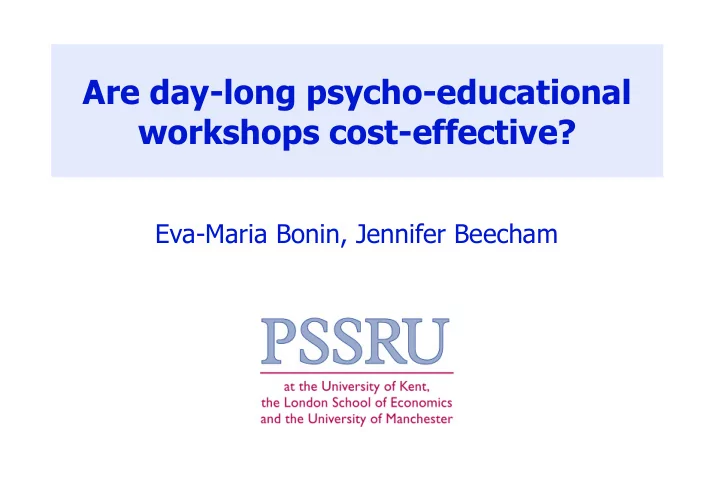

Are day-long psycho-educational workshops cost-effective? Eva-Maria Bonin, Jennifer Beecham
The intervention(s) One-day CBT workshops to improve self- confidence in a community setting Participants included in economic evaluation: 179 intervention (79%) 202 control (87%) 19/06/2014 2
Economic evaluation – methods Service use Costs Cost- effectiveness Outcomes 19/06/2014 3
Supports received by people with low self-confidence CSRI (Beecham & Knapp, 2001) 3 months retrospective, self-reported measure Comprehensive picture of service use Hospital services Primary care Specialist mental health services Social work Counselling Alternative therapy Self-help Third sector 19/06/2014 4
A look at selected services (bsln.) Service Number % Inpatient 28 7% Outpatient 103 27% A & E 34 9% GP 188 49% Psychologist 84 22% Psychiatrist 25 7% Psychotherapist 33 9% Counselling 80 21% Alternative therapy 60 16% Self-help 51 13% Charities and advice centres 30 8% Helplines 48 13% 19/06/2014 5
Support cost before the intervention - average £1,046 4% 2% 2% Hospital 50% Primary care 17% Mental health Social work 1% Counselling Self help Other services Medications 19% 5% 19/06/2014 6
Support costs at follow-up No difference between intervention and control group Intervention: £834 (incl. £161 intervention) Control: £841 19/06/2014 7
Outcomes Significant improvement in BDI Significant improvement in RSES 19/06/2014 8
Economic evaluation - methods Service use Costs Cost- effectiveness Outcomes 19/06/2014 9
How the sausage is made For each participant: NB = (WTP x outcome) - cost What is the change in outcome? What are the costs of achieving this outcome? Question: How much is an improved outcome “worth”? Putting the two together: Willingness to pay (WTP) and Net Benefit (NB) The crucial question: Does the intervention lead to a higher Net Benefit? 19/06/2014 10
A simple example Participant Change in Costs WTP Net benefit BDI Peter +5 £150 £0 (0*5)-150= -150 Paul -3 £0 £0 (0*-3)-0= 0 Mary +8 £250 £0 (0*8)-250= -250 19/06/2014 11
Simple example cont. Participant Change in Costs WTP Net benefit BDI Peter +5 £150 £50 (50*5)-150= 100 Paul -3 £0 £50 (50*-3)-0= -150 Mary +8 £250 £50 (50*8)-250= 150 19/06/2014 12
Simple example cont. WTP Peter Paul Mary 0 -150 -0 -250 25 -25 -75 -50 50 100 -150 150 75 225 -225 350 100 350 -300 550 250 1100 -750 1750 500 2350 -1500 3750 1000 4850 -3000 7750 19/06/2014 13
Quick recap: For each participant: What is the change in outcome? What are the costs of achieving this outcome? Willingness to pay and Net Benefit Does the intervention lead to a higher Net Benefit? Calculate probability that Net Benefit is higher in the intervention group (confidence!) Plot probability against WTP 19/06/2014 14
Beck Depression Inventory (BDI) Probability that intervention is cost-effective 100% 90% 80% 70% 60% 50% 40% 30% 20% 10% 0% £0 £20 £40 £60 £80 £100 £120 £140 £160 £180 £200 £220 £240 Value placed on improved outcomes (WTP) 19/06/2014 15
Rosenberg Self-Esteem Scale (RSES) Probability that intervention is cost-effective 100% 90% 80% 70% 60% 50% 40% 30% 20% 10% 0% £0 £20 £40 £60 £80 £100 £120 £140 £160 £180 £200 £220 £240 Value placed on improved outcomes (WTP) 19/06/2014 16
Conclusions Intervention relatively cheap at £161 No associated increase in support costs Likely to be cost-effective in terms of reducing self-confidence problems and BDI, but willingness-to-pay not firmly established Good option to engage people who receive little in terms of other support, despite high level of distress An accessible, acceptable, (cost-)effective option to include within IAPT 19/06/2014 17
Thank you! 19/06/2014 18
Beck Depression Inventory (BDI) Probability that intervention is cost-effective 100% 90% 80% 70% 60% 50% 40% 30% 20% 10% 0% £0 £20 £40 £60 £80 £100 £120 £140 £160 £180 £200 £220 £240 Willingness to pay Insomnia Self-confidence 19/06/2014 19
Specific outcome measures Probability that intervention is cost-effective 100% 90% 80% 70% 60% 50% 40% 30% 20% 10% 0% £0 £20 £40 £60 £80 £100 £120 £140 £160 £180 £200 £220 £240 Willingness to pay Insomnia (ISI) Self-confidence (RSES) 19/06/2014 20
Quality-adjusted life years (QALYs) Probability that intervention is cost-effective 100% 90% 80% 70% 60% 50% 40% 30% 20% 10% 0% £0k £5k £10k £15k £20k £25k £30k Willingness to pay Insomnia Self-confidence 19/06/2014 21
Recommend
More recommend